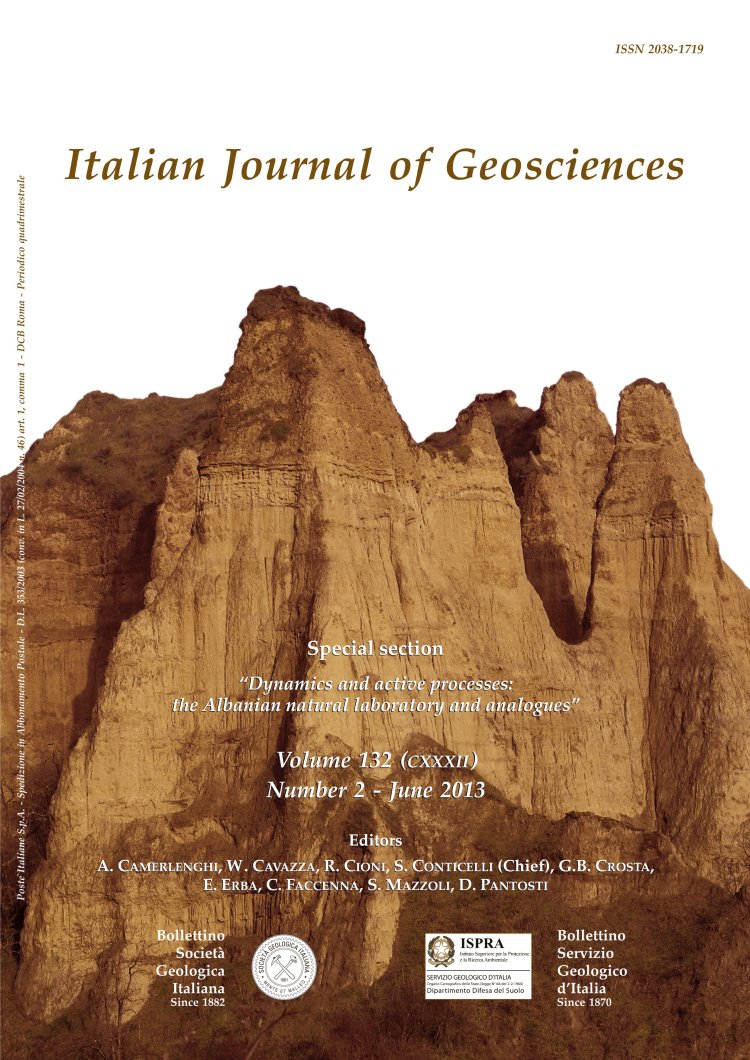
Shallow-marine systems in a wedge-top basin setting: an example from the middle-upper Pliocene deposits of the Southern Apennines mountain front (Basilicata region, South Italy)
Mariangela Pepe(*) & Salvatore Gallicchio(**)
(*) Dipartimento di Ingegneria e Fisica dell'Ambiente, Università degli Studi della Basilicata. V.le dell'Ateneo Lucano, 10 - Potenza. E-mail: mari.pepe81@gmail.com. Tel: +39-320-7466415.
(**) Dipartimento di Scienze della Terra e GeoAmbientali, Università degli Studi di Bari «Aldo Moro». Via E.Orabona, 4 - Bari. E-mail: salvatore.gallicchio@uniba.it; tel: +390805442570.
DOI: https://doi.org/10.3301/IJG.2012.32
Volume: 132 (2013) f.2
Pages: 304-320
Abstract
Middle-upper Pliocene wedge-top deposits cropping out near San Mauro Forte village (Basilicata region), along the Southern Apennnines chain-front, unconformably overlie deformed, lower Pliocene deposits and the pre-Pliocene substratum, represented by Cretaceous to Miocene allochtonous units. The middle-upper Pliocene sedimentary succession is markedly transgressive, with deltaic sands and gravels, overlain by shallow-marine to shelfal hybrid arenites (panchine Auctt.) and open-shelf hemipelagic deposits. This sedimentary succession was syndepositionally deformed, as shown by growth strata and progressive unconformities. Different ranks of unconformity surfaces separate hierarchically ordered, informal stratigraphic units. Two main units have been recognised: the lower unit (designated as Sequence 1) is mainly represented by siliciclastic deposits; the upper one (Sequence 2), is made of hybrid arenites and the overlying hemipelagites. Growth strata in the hybrid arenites indicate a strong synsedimentary control of a N-S trending anticline-thrust.
Siliciclastic deposits of Sequence 1 can be ascribed to coarsegrained delta environments, fed by hyperpychnal flows arising from the chain-front and spreading out towards the foreland areas.
Hybrid arenites of Sequence 2 has a mixed carbonate-siliciclastic to pure silicilastic composition and was deposited in storm-driven, shoreface to open-shelf environments. Skeletal grains of Sequence 2 belong to the foramol-type association, in good agreement with other Neogene and Quaternary mixed carbonate-siliciclastic systems of the Mediterranean area. Stratigraphic-sedimentological data suggest that the aforementioned uplift of the anticline-thrust played a leading role in the establishment of favourable conditions for carbonate production. Regional-scale subsidence has brought to the final drowning of these carbonate factories, overwhelmed by hemipelagic sedimentation.
Keywords
Southern Apennines, middle-upper Pliocene wedge-top basins, hybrid arenites, coarse-grained deltas, synsedimentary tectonics.
Get Full Text